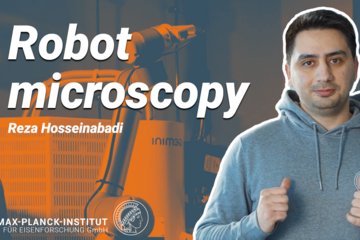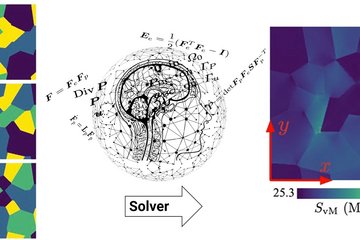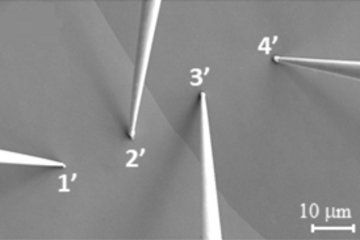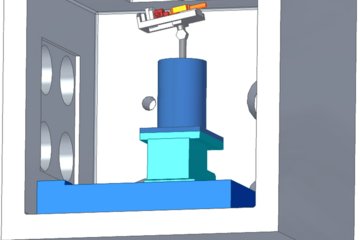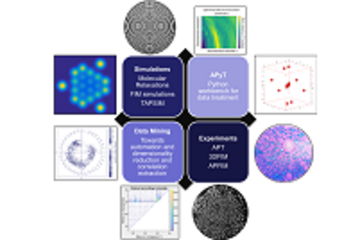All genres
1541.
Teaching
Computerpraktikum: Moderne Computersimulationsmethoden in der Festkörperphysik. Lecture: Blockpraktikum, MPIE, Düsseldorf, Germany, September 20, 2010 - September 24, 2010
1542.
Teaching
Ab-initio based multi-scale approaches to the elasticity of metallic polycrystals and hierarchical biocomposites. Lecture: XI National Congress on Theoretical and Applied Mechanics, Borovets, Bulgaria, September 02, 2009 - September 05, 2009
1543.
Teaching
1) Design of new Ti-based biomaterials by using ab-initio simulations, FEM, and experiments 2) Detailed analysis of an indent. Lecture: AICES – MIT conference, RWTH Aachen, Germany, October 08, 2007
1544.
Teaching
Micromechanics of Metallic Crystals and Fresh Lobster. Lecture: Lecture at MPI für Mikrostrukturphysik, Halle, Germany, 2006
1545.
Teaching
Principles to design and simulate hierarchical materials with property-relevant structural features.
1546.
Thesis - PhD
Development of an ab initio electrochemical cell: Understanding the dielectric properties of interfacial water and Mg dissolution from first principles. Dissertation, Philipps-Universität Marburg, Germany (2024)
1547.
Thesis - PhD
pyiron – an integrated development environment for ab-initio thermodynamics. Dissertation, Paderborn University, Germany (2021)
1548.
Thesis - PhD
Interplay of Real Space and Electronic Structure for Iron-Based Superconductors: An ab initio Study. Dissertation, Ruhr-Universität Bochum, Germany (2021)
1549.
Thesis - PhD
Ab initio based study of the thermodynamics of complex intermetallics. Dissertation, Ruhr-Universität Bochum (2020)
1550.
Thesis - PhD
Development of an ab initio computational potentiostat and its application to the study of Mg corrosion. Dissertation, Ruhr Universität Bochum (2020)
1551.
Thesis - PhD
Ab initio based study of precipitate formation in advanced structural Al-based alloys. Dissertation, Ruhr-Universität Bochum (2019)
1552.
Thesis - PhD
Ab initio phase stabilities of Ce-based hard magnetic materials. Dissertation, Ruhr-Universität Bochum (2019)
1553.
Thesis - PhD
Ab initio study of strongly anharmonic and dynamically unstable systems. Dissertation, Ruhr-Universität Bochum (2019)
1554.
Thesis - PhD
An ab initio study of muscovite mica and formation energy of ions in liquid water. Dissertation, Fakultät für Maschinenbau der Ruhr-Universität Bochum, Bochum, Germany (2016)
1555.
Thesis - PhD
Liquid metal induced grain boundary embrittlement: A multi-scale study. Dissertation, Fakultät für Maschinenbau der Ruhr-Universität Bochum, Bochum, Germany (2016)
1556.
Thesis - PhD
Interstitial solution enthalpies derived from rst-principles: Knowledge Discovery using High-Throughput Databases. Dissertation, Universität Paderborn, Fakultät für Naturwissenschaften, Paderborn, Germany (2016)
1557.
Thesis - PhD
Ab Initio Study of the Low-Index Non-Polar Zinc Oxide Surfaces in Contact with Water: from Single Molecules to Multilayers. Dissertation, Fakultät für Physik und Astronomie der Ruhr-Universität Bochum, Bochum, Germany (2015)
1558.
Thesis - PhD
Multiscale description of super-saturated ferrite in severely deformed pearlitic wires. Dissertation, Ruhr-Universität Bochum, Bochum, Germany (2014)
1559.
Thesis - PhD
Limitierungen der p-Dotierbarkeit von Galliumnitrid: Eine Defektstudie von GaN:Mg auf Basis der Dichtefunktionaltheorie. Dissertation, Universität Paderborn, Paderborn, Germany (2012)
1560.
Thesis - PhD
Numerical Investigation of Scanning Electrochemical Potential Microscopy (SECPM). Dissertation, Fakultät für Physik und Astronomie der Ruhr-Universität, Bochum, Germany (2010)




